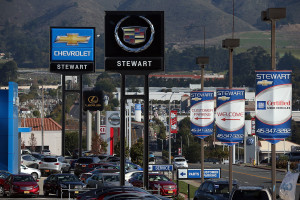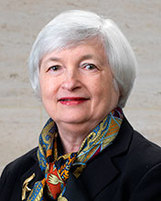
Beyond miles driven: Other recent economic items which could affect — or bypass — collision repair industry
By onBusiness Practices | Market Trends
The increase in “miles driven” by Americans has repeatedly been cited for the third-quarter rise in collision frequency, but there are a few other recent economic reports worth noting when looking at the health of the auto body industry.
Experian’s recent third-quarter automotive market financing report found auto leasing between July and September was the quarter’s highest since the company started tracking it in 2006.
While leasing is only a fraction of the new-car marketplace, the trend could still be good news for repairers. Leased vehicles must be returned as close to pre-accident as possible, and more OEMs are requiring solely OEM parts be used on them, Mitchell industry relations Vice President Greg Horn noted in June.
Nearly 27 percent of new vehicles were leased in the third quarter, not as high as the 31.4 percent in the second quarter but up from 24.7 in Q3 2014, according to Experian.
“As the price for a new or used vehicle continues to rise, leasing has become a more viable financing option for consumers looking to maintain an affordable monthly payment,” Experian automotive finance senior director Melinda Zabritski said in a statement Wednesday. “While consumers can save an average of $84 per month by leasing rather than taking out a loan on a new vehicle, they should make sure leasing fits their lifestyle. Oftentimes there are mileage caps and other considerations that consumers should familiarize themselves with before entering into a leasing agreement.”
Customers who are buying new cars are taking out much longer loans than in the past, something Horn wrote in June could require more repairs rather than total-losses of vehicles with extensive damage.
Experian reported that 27.5 percent of new-car buyers took out loans lasting 73-84 months, up 17.1 percent and a quarterly record. In April-June 2015, new-vehicle loans lasting that long rose 19.7 percent to hit 28.8 percent.
Interest rates
Finally, on a broader loan level, wonks and media who interpret comments by the Federal Reserve indicate that the Fed is about to start raising interest rates. That’s getting a lot of press, so we’ll discuss it a little further and what it actually could mean to the collision repair industry.
It’s technically a little more complicated than “raising interest rates.” For a better explanation of what’s actually happening, see this explanation from the Federal Reserve Bank of San Francisco and this New York Times video:
Essentially, according to the Times and the San Francisco Federal Reserve, the Fed indirectly influences how cheaply banks lend to each other overnight to maintain required reserves. (Banks need a certain amount on hand in case there’s a “It’s a Wonderful Life”-type run on the bank by depositors.)
When banks can borrow money at lower interest rates themselves — known as the federal funds rate — they can lend it cheaply to consumers and businesses and thereby stimulate the U.S. economy. If it’s more expensive for them to borrow money, the amount they charge for loans increases and the economy slows down.
That Fed-influenced rate has has almost been zero since about December 2008, making money virtually interest-free for banks. For financial types, that’s about as close to “free money” as you can get.
But according to Times Wednesday and Friday coverage, Chairwoman Janet Yellen’s speech to the Economic Club of Washington on Wednesday and her comments to the congressional Joint Economic Committee on Thursday are clear indications higher rates are near.
“When the Committee begins to normalize the stance of policy, doing so will be a testament, also, to how far our economy has come in recovering from the effects of the financial crisis and the Great Recession,” Yellen said Wednesday, according to prepared comments. “In that sense, it is a day that I expect we all are looking forward to.”
“Short of saying ‘We’re going to hike rates in two weeks’ time,’” Yellen “could hardly have been clearer,” Pantheon Macroeconomics chief economist Ian Shepherdson wrote, according to the Times.
The Times in September wrote that Yellen expected to raise rates by the end of the year.
In theory, higher rates could eventually slow the boom of consolidators by making it more expensive for the parent companies of Boyd/Gerber, Caliber, Service King and ABRA to buy more stores. (CARSTAR’s parent Driven Brands is the dark horse. CARSTAR franchises, rather than buys, but there are signs its parent might buy shops as well.)
They could also affect how easily independent or smaller MSOs can obtain loans to expand or invest in existing facilities.
But rates are so low and business so good that the Fed’s decision probably won’t affect either, according to collision repair economic analyst Bradley Mewes of Supplement!
“Right now, there’s not going to be a huge impact,” Mewes said of consolidation.
A body shop can deliver 10-14 percent annual return, he said — and with rates likely to still remain low even after an increase, the borrowing buyer is still coming out far ahead.
“A good deal is a good deal,” he said. Most acquisitions fail not because of an increase of 0.25 percentage points in interest but because of “something larger.”
“You’re not going to see a huge drop-off in valuations,” he said.
A rate increase also shouldn’t affect the willingness of a bank to lend to a smaller shop or network either, Mewes estimated.
“It’s not necessarily they’re not willing to lend,” he said. Rather, banks are hesitant to “lend into a dubious business case” as always.
Nor should it be enough of a financial deterrent for those smaller shops to seek a loan for improvements or expansion, he predicted. The Times Friday cited economists’ predictions that the rate would hit between 0.75 percent and 1 percent by late 2016, and Yellen told Congress the Fed would raise rates slowly, according to another Times report.
The effective federal funds rate in October was 0.12 percent, according to the Fed.
More information:
“CONSUMERS LOOK TO KEEP MONTHLY PAYMENTS AFFORDABLE AS LEASING REACHES A RECORD HIGH”
Experian, Dec. 2, 2015
Experian third-quarter State of the Automotive Finance Market
Experian, late 2015
“Why December Is Looking Likelier for a Fed Rate Increase”
New York Times, Nov. 18, 2015
“Janet Yellen Says Economy Is Ripe for Fed Interest Rate Increase”
New York Times, Dec. 2, 2015
“Robust Jobs Report All but Guarantees Fed Will Raise Rates”
New York Times, Dec. 4, 2015
Federal Reserve of San Francisco, September 2004
Images:
Federal Reserve Chairwoman Janet Yellen. (Provided by Federal Reserve)
Cars sit on the sales lot of a Chevrolet dealership on January 3, 2013, in Colma, Calif. (Justin Sullivan/Getty Images News file/Thinkstock file)

